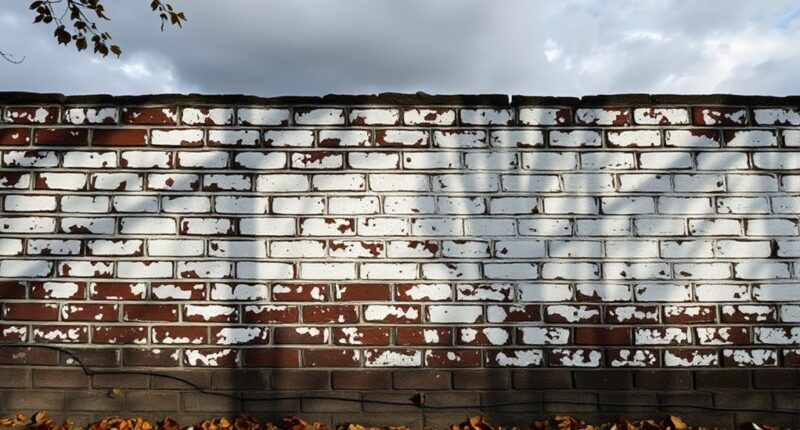The phrase “hitting the wall” comes from marathon runners who suddenly feel an overwhelming surge of exhaustion after hours of exertion, marking a physical and mental limit they find hard to overcome. This moment signifies a sharp energy decline, often due to glycogen depletion, and has become a vivid metaphor for encountering insurmountable obstacles in various areas of life. To discover how this phrase evolved and why it’s so powerful, keep exploring its origins.
Key Takeaways
- The phrase originated from long-distance runners experiencing sudden energy depletion during marathons.
- It describes hitting an invisible physical and mental barrier after hours of exertion.
- Athletes first used it to depict a point of exhaustion and inability to continue.
- Over time, it evolved into a metaphor for overcoming insurmountable obstacles in life.
- Cultural significance emphasizes endurance, resilience, and the importance of proper nutrition to delay the phenomenon.

The phrase “hitting the wall” is commonly used to describe a sudden and overwhelming obstacle, especially during physical activities like running or cycling. You might have heard it among marathon runners or cyclists who suddenly feel drained, exhausted, and unable to move forward despite their training. Its origins trace back to the history of marathon running, where athletes encountered a sharp decline in energy after hours of exertion. This moment of complete fatigue became known as “hitting the wall,” a vivid metaphor for crossing a point of no return in physical endurance.
Marathon history is rich with stories of runners pushing their limits and experiencing this phenomenon. The phrase evolved over time from the early days of long-distance racing, when runners struggled to maintain pace after hours of continuous effort. As marathons gained popularity in the early 20th century, athletes and spectators started to recognize this critical moment of exhaustion. It was often described as hitting an invisible barrier, a mental and physical wall that seemed insurmountable. Over decades, “hitting the wall” became a common expression, capturing this shared experience among endurance athletes.
The phrase’s evolution reflects both the physical reality and the psychological challenge faced during marathon events. Initially, it was used primarily by runners and coaches to describe a specific physiological state—depleted glycogen stores and extreme fatigue. But over time, it also took on a metaphorical meaning. Now, people use “hitting the wall” to describe any sudden, seemingly insurmountable obstacle in life, work, or personal pursuits. Its vivid imagery makes it a powerful way to describe moments when everything feels overwhelming and progress halts abruptly.
Additionally, understanding the importance of proper nutrition, such as consuming Idli Sambar or other carbohydrate-rich foods, can help delay the onset of hitting the wall by maintaining energy levels during endurance activities. As marathon running grew more popular worldwide, the phrase became embedded in sports culture. It’s no longer just a technical term but a symbol of resilience and mental toughness. You might think of it as the point where physical pain and mental doubt collide, forcing athletes to dig deep for motivation. The phrase’s evolution from a literal description rooted in marathon history to a broader metaphor highlights its universal appeal. It’s a reminder that, whether in sports or life, everyone faces walls—moments of intense challenge that require perseverance to overcome.
Frequently Asked Questions
When Did the Phrase First Appear in Popular Culture?
You’ll find the phrase first appeared in popular culture in the 1960s, especially among marathon runners and athletes. Its historical origins trace back to sports, where it described the moment when energy depletes, and mental strength falters. Cultural references in media and sports commentary soon popularized it, making “hitting the wall” a vivid metaphor for facing a sudden obstacle or burnout in various life situations.
Are There Equivalents of This Phrase in Other Languages?
A picture is worth a thousand words, and many languages have their own expressions for hitting a wall. You’ll find translation equivalents like the French “coup de bambou” or the German “die Mauer im Kopf,” reflecting cultural expressions for mental or physical exhaustion. These phrases show that, across cultures, people recognize burnout or hitting limits, emphasizing universal human experiences through different language nuances.
How Do Athletes Typically Recover From Hitting the Wall?
When you hit the wall, you usually recover through a combination of nutritional strategies and mental resilience. You might consume quick carbs like gels or sports drinks to boost energy levels and help your muscles recover. Simultaneously, focusing on mental resilience keeps you motivated and prevents negative thoughts from taking over. Staying positive, breathing deeply, and reminding yourself of your training help you push through and regain your strength.
Has the Phrase Been Used in Literary Works Before Sports?
Like a shadow stretching beyond the race track, the phrase has appeared in literary references before sports, serving as a metaphorical usage for moments of profound exhaustion or crisis. Writers often use it to symbolize emotional or mental burnout, making it a powerful literary device. You’ll find it in poetry and novels, where it captures the universal experience of hitting a personal wall, illustrating struggles that go beyond physical endurance.
Does Hitting the Wall Occur in Activities Beyond Endurance Sports?
You experience hitting the wall in activities beyond endurance sports, like intense studying or demanding work, when mental fatigue and emotional burnout set in. You might feel exhausted, overwhelmed, and unable to continue effectively. This phenomenon isn’t limited to physical effort; it reflects your mental and emotional limits. Recognizing these signs helps you take breaks, recharge, and prevent burnout, ensuring you stay productive and maintain well-being across various challenging pursuits.
Conclusion
Now that you know where “hitting the wall” comes from, you’ll see it differently next time you hear it. Did you know that marathon runners often hit this point around mile 20? That’s when energy drops and mental fatigue kicks in, making it a real challenge to keep going. Understanding its origin helps you appreciate the struggle and resilience involved, whether in sports or life’s hurdles. Keep pushing forward—you’ve got this!









